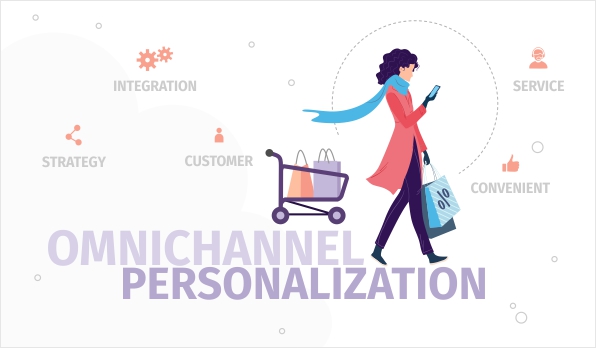Gone are the days of ‘Online Shopping versus Retail’. Now is the time of Omni-channel marketing which primarily focuses on Personalization, shifting the focus from sales to customer experience.
It’s about all CUSTOMERS, not channels.
So What is Omni-channel Personalization?
Let’s break this down
Omni-channel means seamless communication with customers across all the channels – from retail to online to phone, or using all your channels to communicate with your customers.
Omni-channel customer experience is all about providing consistent and relevant customer experience to your customers across all the points of contact, as they see your business as a single identity, not as channels.
Now enters Omni-channel personalization which is all about tailoring customers’ experience or providing individualized experience based on the real-time data companies collect about individuals from multiple channels.
Let’s understand this from CMOs perspective
You probably know by now what omni-channel personalization is, but here are some comprehensive definitions based on experience and feedback from the industry experts. These interpretations will help you see Omni-channel personalization beyond its literal meaning.
It will also give you clarity on what goes into implementing omni-channel personalization and what changes you need to implement on the organization level to make a shift.
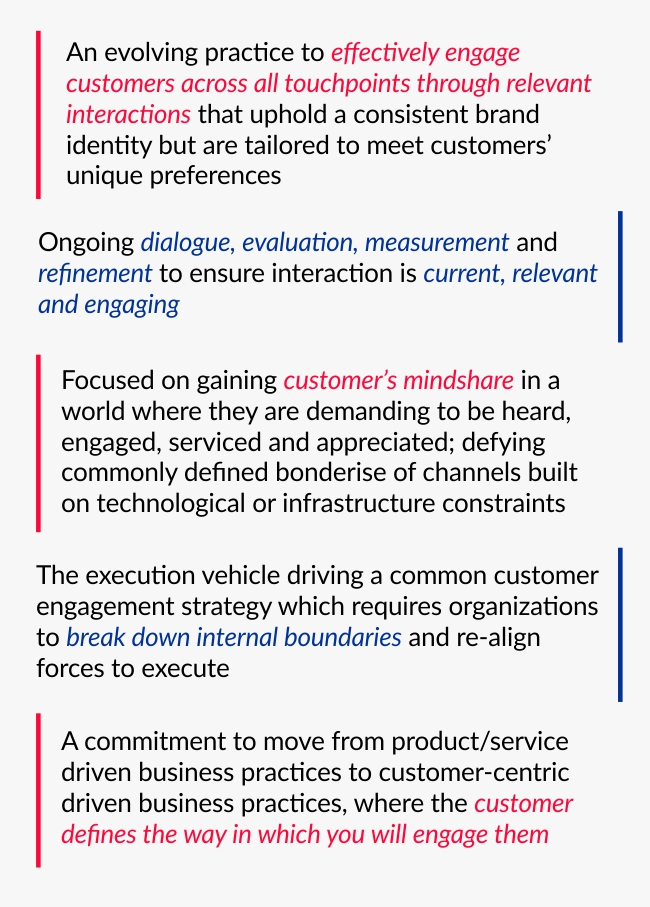
Source
Difference between Omni-channel and Multi-channel Marketing
Omni-channel Marketing and Multi-channel Marketing are often used interchangeably but they are not the same. You may have taken your first step to omni-channel marketing by being available for your customers on multiple channels, but don’t assume you have not gone full-throttle on Omni-channel marketing unless you seamlessly integrate all your channels.
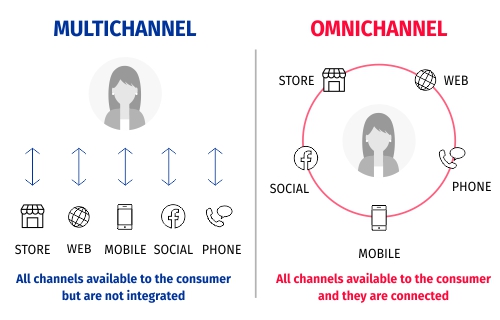
Multichannel Marketing – Channel specific
If you have an established presence on multiple channels like website, email, publishers, messengers, phone and are communicating with your customers on all these channels, you are successfully running a multi-channel marketing strategy. Here, you focus on maximizing the performance on each marketing channel.
However, you take separate actions in the multiple siloed channels.
Omnichannel Marketing – Channel-less
Omni-channel marketing is more of an integrated approach to customer engagement. If you seamlessly integrate all your channels to create a unified customer view, you are running a successful omni-channel marketing strategy. It is all about ditching marketing siloes and creating a truly continuous customer experience.
The simplest way to explain this is…
If your customer has bought something from your store or website, you can retarget them on their preferable social media platforms. And if they buy anything, you can send them an email recommending products based on their last purchase.
Rephrasing Kristen McCabe from G2 Crowd
Omni-channel translated to omniscient – meaning “all-knowing”. Integrating all the platforms together creates a unified view of your customer journey, which everyone in your organization is aware of.
This way you are being consistent, seamless and relevant to your customers on all the platforms at all times. It requires all the departments in your organization to work in tandem.
Omni-channel Personalization – The future of Marketing
Omni-channel personalization takes your marketing game to a notch up. It allows you to gain a deeper understanding of your customers based on their interactions with your brand on multiple channels. And this helps you tailor their experience across all the channels. With this strategy, you can be as relevant and contextually consistent as possible with your customers.
For example, if your customer scours your App or website to check a few products but does not make a purchase, you can prompt them to make that purchase by sending a personalized email showing all products they looked at on the website or app. And also, remarket those products on their favourite social media channels. This is the simplest example of omni-channel personalization.
Earlier, brands were limited channel-specific interactions. Some of them were highly dependent on emails and some were engaging with their audience on their preferable social media channels. And then there were some brands that made the most of both the channels. But then came the revolutionizing multi-channel marketing which allowed brands to maximize the performance of individual marketing channels such as a website (for web push), App (for App push), and WhatsApp (for more engagement) apart from Email and Social media. However, this kind of infrastructure created silos and a mix of structured and structured data. This simply means, different departments for different channel management did not allow brands to see what their customers are doing on each of these channels, which prevented marketers from gaining a deep understanding of their customers and designing unique interactions for them across the channels.
Omni-channel marketing, on the other hand, is the ability to understand your response and engagement on each channel and customizing their experience on every digital touchpoint. So no matter where the interaction has come from, you have the ability to collect that information and deploy a strategy to create contextually informed marketing messages for a consistent experience.
What do your customers expect?
“90% of customers expect consistent interactions across channels. (SDL)”
As more and more brands are steadily catching up with omni-channel personalization trend, customers actually looking to form a healthy relationship with brands and desire a consistent experience across all platforms. They receive a deluge of communication coming from every direction and brands have now started to understand that the customer buying journey isn’t going to be linear like it used to be.
Your customer might look at your products every time your ad pops up on social media channels but they might make a purchase via App push. When brands push their customers down the funnel of a narrowly-defined buying cycle, they fail to connect due to a disjointed experience with the brand.
If we look at the scenario, a lot of e-commerce brands have started capitalizing on the data they collect about customers from across the channels with the help of personalization technology solutions. 55% of companies have no cross-channel strategy in place. (The CMO Club). Omnichannel shoppers have a 30% higher lifetime value than those who shop using only one channel. (Google).
Many marketers and retailers are used to think about channels separately but your customers don’t think that way. They don’t care about channels. Instead, they desire a single cohesive experience that’s truly channel-less. This is the best time to seize the opportunity and improve your customer experience. That’s the only way forward.
Steps to implement omni-channel Personalization Strategy
- Make customer experience your top priority
While everyone, from CMOs to Marketing Managers, agrees to the customer-centric approach in theory, executing that approach across departments is certainly difficult than you think. Before you dive right into the technology that will help you optimize your omni-channel marketing strategy, get everyone on the same page on the organization level.
To break the siloes and understand what every department is doing when interacting with customers, talk to everyone right from senior management to mid-level to junior people and show them how their actions affect customer experience, even if they don’t realise it.
This will not only put you on the internal path to success but also help you understand what collaborative efforts you need to make so that you can start working towards the same goal – implementing your new customer-centric omni-channel marketing strategy.
- Take the data-driven approach
Your customer data has a direct relation to your understanding of your customers. These are directly proportional to each other, meaning the more data you have the deeper understanding you get about customers. However, to get started, use whatever first-party data you have. Don’t understand estimate the potential of your data. Use data from CRM (Customer Relationship Management), customer profiles, offline data (if possible), and other sources.
- Understand the difference between CRM and CDP ( Customer Data Platform)
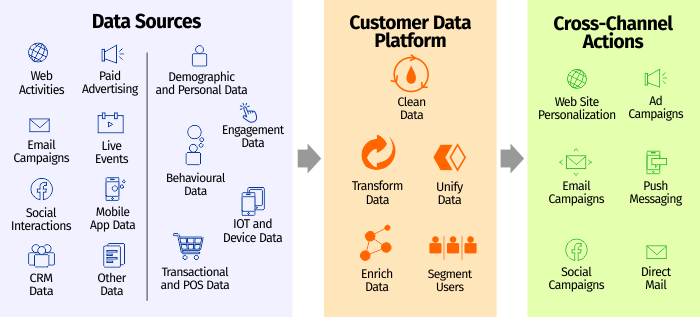
Customer Data Platform is the very basis of Omni-channel marketing and it’s important for marketers to be crystal clear about the difference between CRM and CDP. CRM, managed by IT and used by the sales, is a customer relationship management platform that is used to manage the company’s relationship and interactions with customers and potential customers. CRM helps sales people track customer details which are used during the sales process.
Do the CRM and CDP features coincide? The answer is yes. CRM can be integrated with an automation platform which helps using the CRM data for marketing campaigns. However, the overall scope and channel integration opportunities are limited.
CDP is a marketer-owned system that helps conduct a deep analysis of customer behaviour by tracking customer activities. According to David Raab (the founder of CDP Institute), “A CDP is a marketer-managed system that creates a persistent, unified customer database that is accessible to other systems”. And Forrester defines CDP as a platform that consolidates and integrates data from multiple sources to create a single trusted repository that supplies data as and when required by analytical and operations systems to launch campaigns via Martech stack.
So whatever omni-channel marketing and personalization platform you want to add to your marketing tech stack, it has to be integrated with CDP which is designed to track historical and behavioural data to create a richer view of customers. You can take a view of complete profiles of your customers to create personalized buying journeys and overall individualized experiences at scale.
- Segment your audience
Now that you have compiled your data and have a unified view of your complete customer profiles, start looking for data patterns and understand your customers’ path to purchase. Based on that, segment your data into groups. As yourself
- If there are any repeat purchases or renewal patterns
- Who are your loyal customers and is there any similarity in their demographics?
- Who has lapsed and why?
Creating segments is important and any can do that. No matter what size your business is, if it’s an e-commerce platform, you can always track your customers buying patterns. Who makes a purchase once a year or once a month? Who opens your emails and click on call-to-action? Who abandoned the cart?
This information can help you nature your customers by creating personalized messages based on their choices and buying pattern. A lot of e-commerce businesses swear by the AI-powered omni-channel personalization technology which allows them to send personalized recommendations to their customers based on their buying behaviour, creating a delightful customer experience.
Special Tip
Make sure your segments are not too nuanced. You need to understand where your customer is in the buying cycle. If your customer is at the top of the funnel, don’t send them mid-funnel messages which your customers can’t relate to. If you have a problem with brand awareness, don’t be too granular with your segment. In such a case, build brand affinity first.
- Invest in Advanced Personalization
For enhanced omni-channel customer experience, invest in advanced-level personalization to send personalized messages for the segments you have created. For example, if your customer has been shopping from your summer collection from the last two years, don’t forget to send them personalized messages regarding your latest summer collection.
Your personalization technology will help you collect important information about your website visitors. This information will help you understand what your customers are most likely to buy, which will help you create content for your re-targeted ads.
- Train employees across every level
Make sure your employees know what’s going on as far as your marketing campaigns are concerned. If you have a 20% discount going on a certain brand or product range, your in-store staff, customer care executive need to have this information.
Just imagine how would your customer feel if he or she wants to buy that product on 20% discount from your offline store and the sales staff at the store has no clue about it. Your instore staff can provide the level of personalization that machines can’t provide. Train your staff across departments to ensure a truly personalized experience.
- Maintain accurate inventory
Let’s say you have a 50 % percent discount on certain products and you keep retargeting your customers across channels regarding the same. However, when your customer clicks on the ad to buy that product, it shows out of stock or the most common sizes aren’t available. This will be a big put off for your customer especially if such ads appear several times. Maintaining accurate inventory, across the website, mobile, instore can have a significant impact on your customer experience.
Ways to implement efficient Omni-channel Personalization
- Email and Web/App Personalization
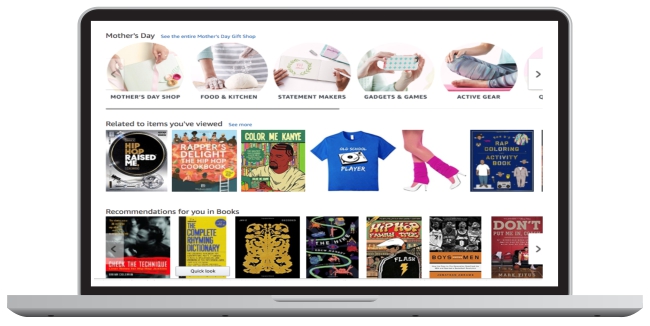
Email and website personalization is your lowest hanging fruit. Perfect the art of sending personalized email communication regarding product information and content related to their previous orders or enquires. You can always create an individualized website or App viewing experience for returning customers or even make smart recommendations to first-time visitors based on real-time eye-ball data or search behaviour. If you have onsite chat service and your returning customer starts the chat, start with their feedback request on their last purchase or the last interaction irrespective of the channel they had it on.
- Historical analysis to send contextually consistent messages
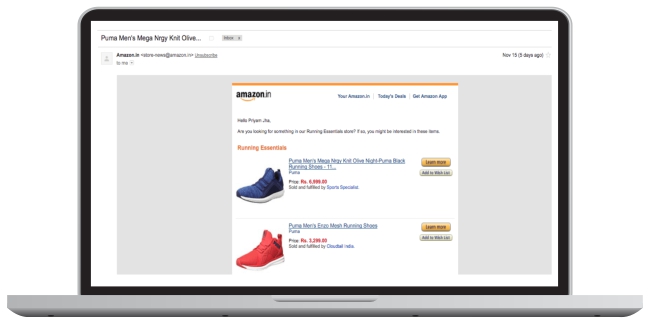
The whole idea of unifying customer data is to identify data patterns that help understand customer behaviour. Based on their location, device, search and buying behaviour, you can go as granular as possible with your segments. This will help you create contextually relevant content and offers targeted to individual customer interest. In combination with this, you can send contextually relevant information to your segments based on their geography, weather and day-parting patterns.
- Mobile Personalization
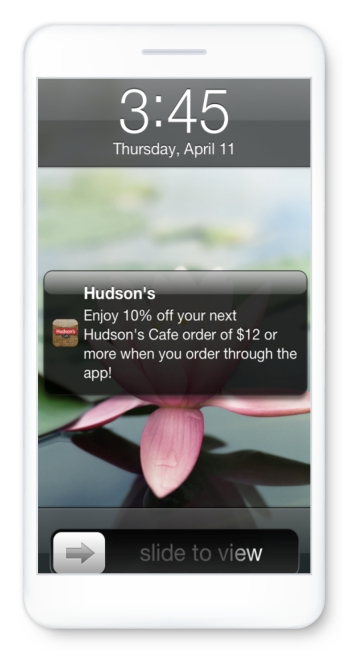
Mobile and tablet-specific personalization is often a big focus as it allows you send geo-targeted offers and enhance the experience for on-the-go shoppers. Data patterns identified for web or app needs to align with mobile and tablets. Make sure you have seamless data sharing within and across all your channels.
- In-store Personalization

Your instore staff can’t provide a complete personalized experience to your instore customers without customer profiles or data. The best way to extend personalization across your brick and mortar locations is to arm your sales staff with tablets to manage clients and equip your stores with kiosks and digital displays. Make sure you sync your POS systems with Omni-channel solution to deliver personalized experience on your offline and online stores.
- Contact Centre Personalization
Customer service agents are often dependent on CRM data to access customer profiles and information during their sales calls. However, the information they access is not updated real-time which will prevent them from providing personalized experience. The information regarding your customers’ latest interaction needs to be stored on a unified timeline so that its accessible to chatbots or human agents at all times. So that your agent is able to provide personalized experience when the customers reaches out to them.
How to evaluate the right omni-channel Personalization Solution
Integration and configuration time and effort
Configuration time and effort is the biggest concern for many marketers. Always choose a solution that easily syncs with your existing tech stack and take the least amount of tech intervention.
Clear visibility of performance analytics
Make sure omni-channel personalization engine has a smart KPI-driven approach and has clear visibility of reporting data resulting from your marketing campaigns
Price plan should fit in your marketing budget
A lot of marketers shy away from implementing omni-channel personalization for its high configuration cost, especially small or mid-level businesses. Make sure you choose a solution that fits in your marketing budget and does not inflate your operations cost.
Timely customer support
A lot of marketers complain about inefficient and untimely customer service response which can affect productivity and marketing campaigns. Do ensure your omni-channel personalization solutions’ customer support is available for both big and small clients.
Intuitive UI
Choose an omni-channel personalization solution that has a smart, user-friendly UI that provides the flexibility in terms rigorous testing and experimentations.
How much it takes to show results
Once you seamlessly implement personalization across platforms, it’s important for marketers to know when will they start seeing the results. Always pick the solution which promises fastest engagement and conversion-driven results.
Parting thoughts
Consumers these days expect personalized experience across channels and touchpoints. And brands can’t afford to cut corners when it comes to providing 1:1 experience to their customers. Integrating all your channels, powering it with the best personalization solution, and providing consistent experience is the need of the hour, especially during the pandemic times. Your consumers heavily rely on online shopping at this point of time. The experience that you will provide to your customers now will stay with them well-past the crisis times.
 Holiday Sales Are Won Now — Grab the 2025 Holiday Marketing Guide to Unlock More Revenue.
Holiday Sales Are Won Now — Grab the 2025 Holiday Marketing Guide to Unlock More Revenue. 








